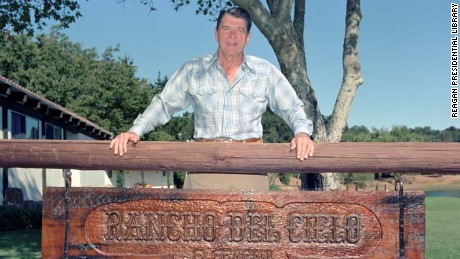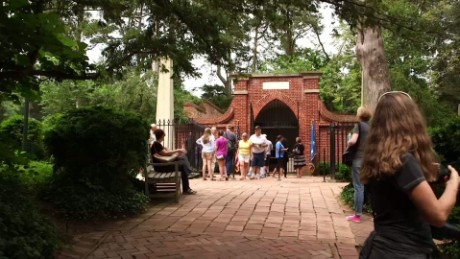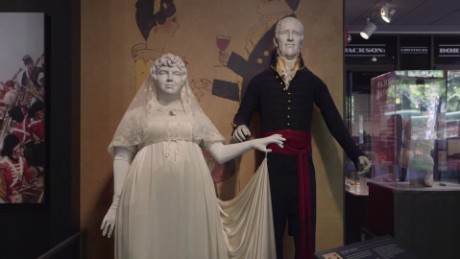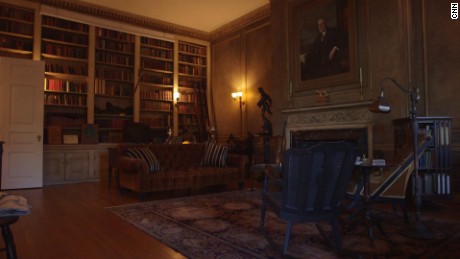

- Reagan's
ranch - Mount
Vernon - The
Hermitage - Wilson's
House - The 'Texas
White House'
How LBJ scared visitors at his ranch
The media called it the “Texas White House,” but to LBJ the ranch was home. It was a place where he could work -- and have a little fun.
President Lyndon B. Johnson barked into the two-way radio: "One to Mike, One to Mike!"
Secret Service Agent Mike Howard, riding behind the President's aqua vehicle in a more sedate station wagon, jumped on his cue.
"Go ahead, sir."
"Did you get the brakes fixed on this car?"
"Mr. President, we haven't been able to get it to the garage."
"You mean the brakes are NOT FIXED?!"
"It's OK, Mr. President. I think you can handle it."
Johnson hung up abruptly, careening down the concrete ramp at Granite Shoals, Texas, toward water, terrified passengers in tow.
At the very last moment, as the car hit the lake, came the reveal: Johnson was driving a 1962 Amphicar, the only mass-produced civilian amphibious automobile. He didn't know what to do with that gift when he received it -- until he got into it and saw what it could do.
For the next 13 months, the nation will focus on choosing its next president, and voters' first chance to hear from the Democrats as a group is this Tuesday at the CNN Facebook Democratic Debate in Las Vegas. This intense campaign waged in the moment to determine the nation's future also offers an opportunity to look backward -- a chance to explore stories of past presidents and the places that defined them.
About this series
Presidential Places is a weekly series on past presidents and places they loved. Over five weeks, we look at iconic presidential sites from Mount Vernon to LBJ's ranch.
Johnson's Central Texas ranch was his refuge. He flew to Hill Country outside Johnson City 74 times -- and spent 490 days there, about a quarter of his presidency. The press dubbed it the "Texas White House," but to the Johnsons, it was home. A pillow in his study -- a present from a neighbor who first vetted it with Lady Bird Johnson -- sums up his feelings about the place: "This is my ranch, and I do as I damn please!"
He was a workaholic and a voracious consumer of information in all forms: The New York Times, the Washington papers, the San Antonio papers. Three televisions stood next to each other in his living room and also in his bedroom so he could watch the networks -- ABC, NBC and CBS -- simultaneously, often angered and upset by what he saw.
"As the situation in Vietnam deteriorated, the news coverage really got under his skin," supervisory agent Mike Ryan said during a private tour of LBJ's ranch, now a national historic park that brings in about 75,000 visitors a year.
Johnson had as many as 300 telephone lines installed, and a white phone still hangs underneath the head of his dining room table, right next to his imitation cowhide chair (the "god-awful chair," Lady Bird called it). He had a 70-foot phone cord built so his phone would reach his pool.
In "The Triumph & Tragedy of Lyndon Johnson," Joseph A. Califano Jr., Johnson's chief domestic adviser, writes, "Life at the ranch would always be unpredictable. We never knew when we would work or play."
Johnson's staff worked on the genesis of the Great Society here and coined the phrase "War on Poverty." They agonized over the military escalation in Vietnam, the bloodshed that haunted the nation for decades and ultimately ended Johnson's hopes for a second presidential run.
But there were plenty of hijinks here as well, and the Amphicar was one of Johnson's favorite tricks.
He'd drive it to Granite Shoals, about 40 miles northeast of his ranch. Howard, now 84 and a raconteur who would surely delight his former boss with his lively storytelling, started working for Johnson at 32 and was a frequent companion. The skit wasn't his idea, but Johnson was the President and Howard played along every time.
"We learned our lines: 'Well, Mr. President, we couldn't get to it this week. We'll try to get to it next week.'" The response was also consistent: "The women would squeal and the men would say, 'Look out, Mr. President!' "
Signs next to the car, which is still at the ranch and remains surprisingly shiny so many years later, record that there were 3,878 Amphicars manufactured in West Germany from 1961 to 1968. They came in four colors: beach white, fjord green, regatta red and lagoon blue. Johnson had the blue.
Califano recounts his experience driving around with Johnson in the small blue car with the top down:
"We reached a steep incline at the edge of the lake and the car started rolling rapidly toward the water. The President shouted, 'The brakes don't work! The brakes won't hold! We're going in! We're going under!
"The car splashed into the water. I started to get out. Just then, the car leveled, and I realized we were in an Amphicar. The President laughed. As we putted along the lake then (and throughout that evening), he teased me. 'Vicky, did you see what Joe did? He didn't give a damn about his President. He just wanted to save his own skin and get out of the car.' Then he'd roar."
One fleeing passenger fared less well.
As the President and Agent Howard ran through their usual routine, they could see a passenger bailing out of the backseat and then collapsing in the water. Howard and the President's physician jumped out and ran to her.
"We're administering to her, and she sprained her wrist, she sprained her ankle, bruised her shoulder, had a concussion and was blubbering. By this time, she was crying," Howard recounted. The two men lifted her up and scooted her out of the water as the President and her husband came charging over to her.
The President is "standing right over her. And he says, 'My God Almighty ... Why did you jump out?'
And she looks up at him, like 'Look, Stupid.' She had that look on her face, very determined. You know how a woman can be. And she said, 'Mr. President, I can't swim!' "
The near-calamity didn't dampen Johnson's love for the Amphicar.
But after that, he gave his guests a heads-up that it was also a boat.







